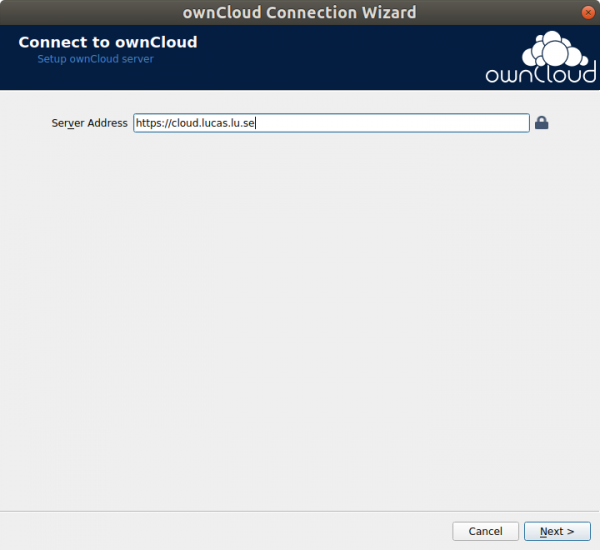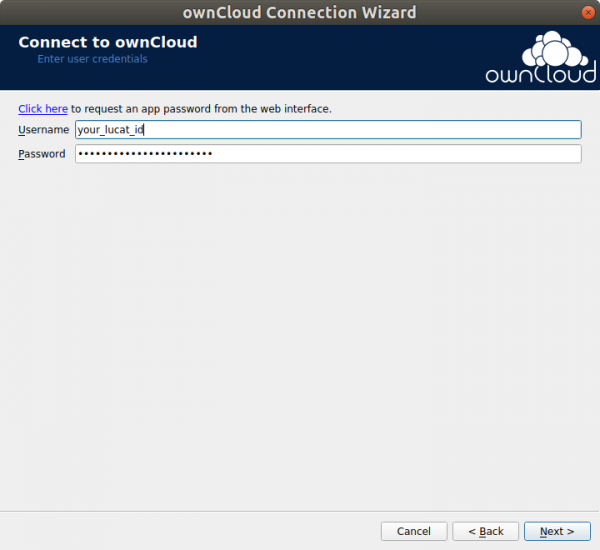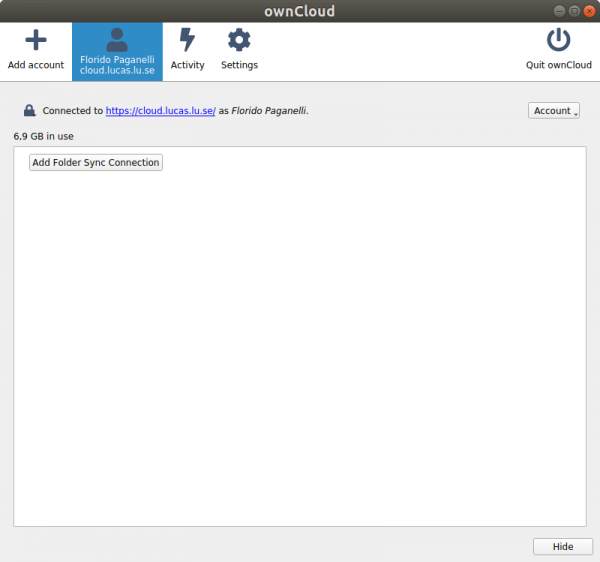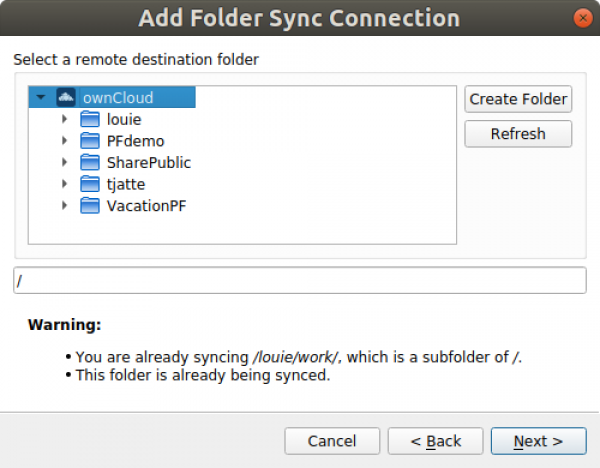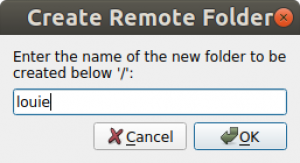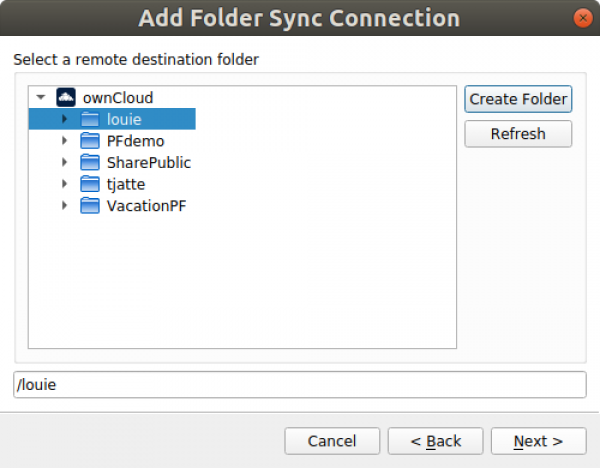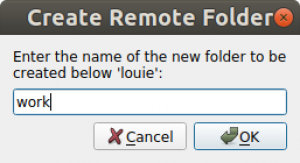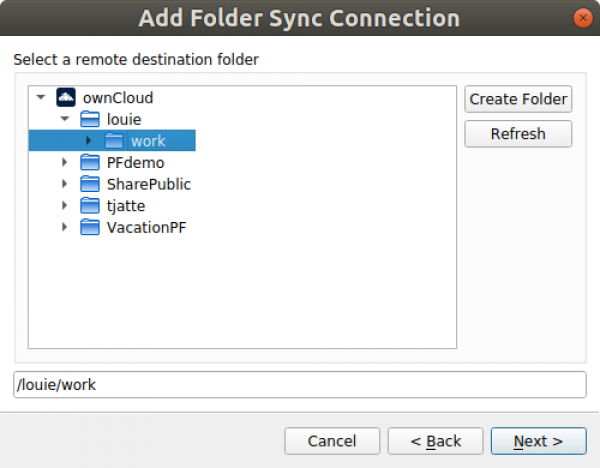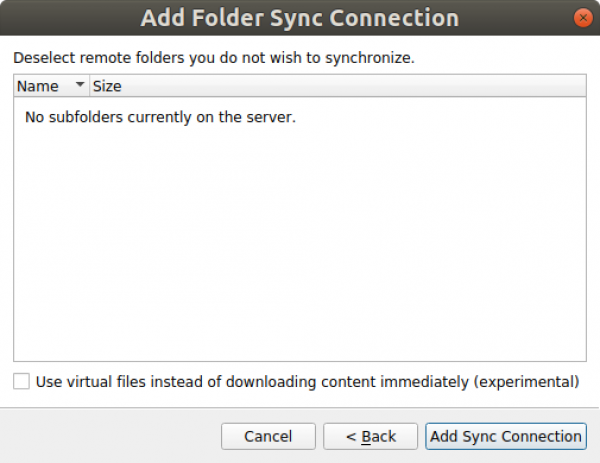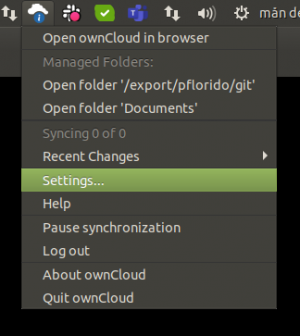Table of Contents
Setting up backup with owncloud
This page describes how to use ownCloud to backup your files. If you want to use it as a share and synchronization tool (like DropBox or Box), then please refer to this page: sharing files with ownCloud.
Currently we cannot offer enough space for a total backup of your home folder, especially if you're saving large datasets, videos or other large size files. Also, ownCloud is not good for such large files. OwnCloud shines in handling small files.
The current minimum allocated space per user is 10GB. You can exceed it, but in case this happens you may be asked to reduce the backup size if required.
It does automatic versioning so you can go back and forth in time among the saved versions of the files.
The suggested way to use ownCloud for backup assumes these ideas:
- A folder called
workin your home folder is the primary part of the filesystem to be backed up. - You can add more folders to the owncloud backup if you want.
- on the ownCloud server you create a folder for each laptop that you want to synchronize, so that the folder structure on owncloud looks like this:
- laptopname1/
- workonlaptop1/
- laptopname1-win/
- workonWindowslaptop1/
- laptopname2/
- workonlaptop2/
If you have software installed on the system, you may:
- install it locally inside your
workfolder - just save in your
workfolder the software configuration required for it to work so that you can restore it - add a synchronized folder to your ownCloud
Prerequisites
You need a LUCAS account and the ownCloud desktop app installed.
Preparing your machine
- Locate your home folder path:
- On Linux, usually
/home/username - On MacOSX, usually
/Users/username/ - On Windows, usually
C:\Users\username
- Create a
workfolder in your home or in your desktop, and note the full path- On Linux, usually
/home/username/work/ - On MacOSX, usually
/Users/username/work/ - On Windows, usually
C:\Users\username\work\
Test your login on the ownCloud server
Connect using your favourite web browser to https://cloud.lucas.lu.se and login with your LUCAS credentials. If it doesn't work contact Florido Paganelli
Take some time to browse around the folder structure. Typically there are already preloaded folders and a manual.
Connect to the server using the Desktop app
Start the desktop app. You can search for the string 'owncloud'. The icon looks like this (varies depending on operating systems) ![]()
At this point the app will ask whether you want to synchronize everything from the server. This is recommended if you want to synchronize folders shared with you by other users or if you want to sync with other computers, but in this page we are configuring a backup, so I do not recommend it.
Instead, for backup purposes I suggest to select “Manually create folder sync connections” and click on Connect… 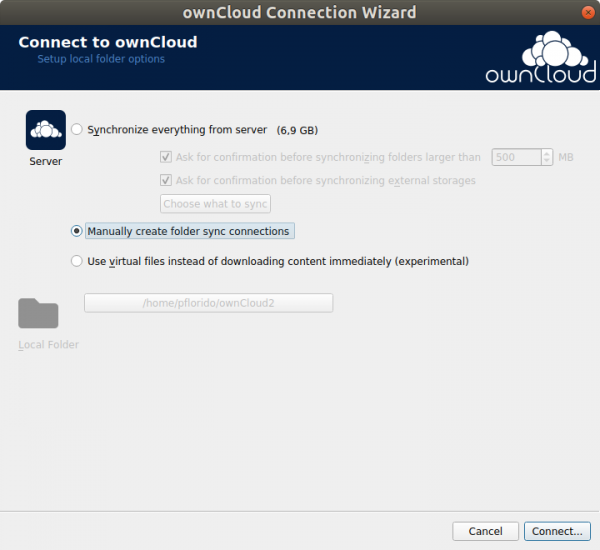
Configure the folders to backup
In this section I will describe how to configure ownCloud to do a backup of the work folder.
If you do not like this behavior, just change the “work folder” path below with whatever folder you want to backup.
You will be now presented with a dialog.
Add folders to backup
- When asked to pick a local folder on your computer to sync, write your
workfolder path that you noted as described in section Preparing your machine. In the example below, a work folder in my home folder. Click onNext >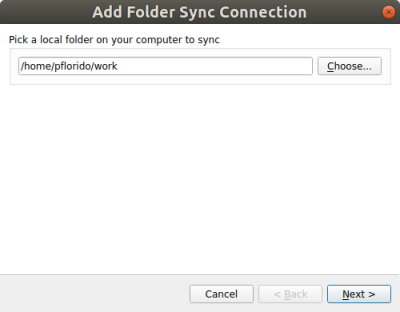
- The dialog “Select a remote destination folder” shows you the existing folders on the ownCloud server. I recommend you create a server folder for each laptop in use so that you do not confuse the backups. You can choose your laptop name or any other word that helps you remembering which computer it is. Mine is louie so I will use that in the example below.
At this point ownCloud will start synchronizing with the server. It may take quite a while before it's done if you already have data either on the server on on your local machine. In the dialog that opens you can see what is synchronized.
You can repeat the same procedure to add any other folder you want to backup inside the computer name's folder.
Exclude some folders from being synchronized
![]()
![]()
![]()
![]() WARNING
WARNING ![]()
![]()
![]()
![]()
Newer versions of the client delete the local files when un-ticking synchronization. This is by design. The ownCloud developers only support this kind of syncronization.
Hence I recommend not to use this feature for backup.
If you do not want to backup a subfolder inside a synchronized folder maybe you should rethink what you want to backup, or select individual folders to backup instead.
![]()
![]()
![]()
![]() WARNING
WARNING ![]()
![]()
![]()
![]()
While ownCloud is running, you have the chance of deciding whether you do not want to synchronize a folder any longer.
- Click on your account name, and click on the small triangle next to the name of the synchronized folder in order to see the list of folders. For every remote folder (the one with the cloud) you will see a list of synchronized folders.
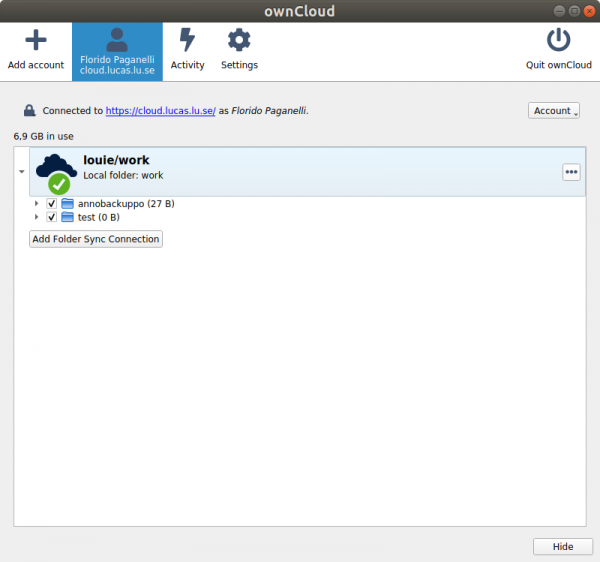
- Simply un-tick a folder to stop ownCloud from synchronizing that folder, then click on
Applyto accept the changes. In the example below I am synchronizingtestbut notannobackupppo.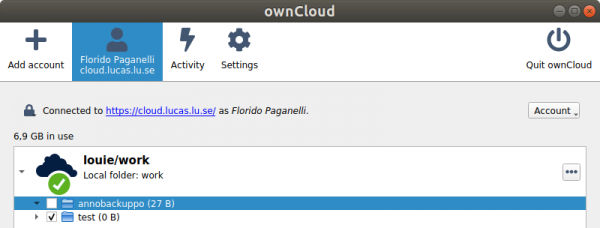
- NOTE: the folder will not be synchronized, but the files uploaded so far are still on the server. You can see them by logging in into https://cloud.lucas.lu.se
- NOTE: the files will be REMOVED from your local machine, so make sure you synchronized them on the server at least once!
- You can at any time restart synchronizing the folder by ticking it again.
Exclude some folders/files from the backup by regular expression
This is the recommended way to exclude files from backup, but it's not so easy to use.
This needs to be done before adding folders to synchronize, or ownCloud will upload all the files under a certain folder. This is done using pattern matching. There is already a predefined set of excluded patterns in ownCloud.
- Click on the Settings gear to setup excluded folders
- Click on
Edit Ignored Files - Click on
Add - Write
nobackupor the name of the folder or file you want to exclude from backup. - Press
OK - Any filename that contains the folder
nobackupas one of its paths will be excluded by owncloud.- For example, the file
test/test/nobackup/filenamewill not be backed up.  For example, the file
For example, the file test/thisisnobackups/filenamewill be backed up!
- You can add any other folder to exclude. Below some suggestions for each operating system:
- Linux:
.cache,.thumbnails - Windows:
System Volume Information,hyberfil.sys,pagefile.sys,swapfile.sys - MacOS X: TODO
